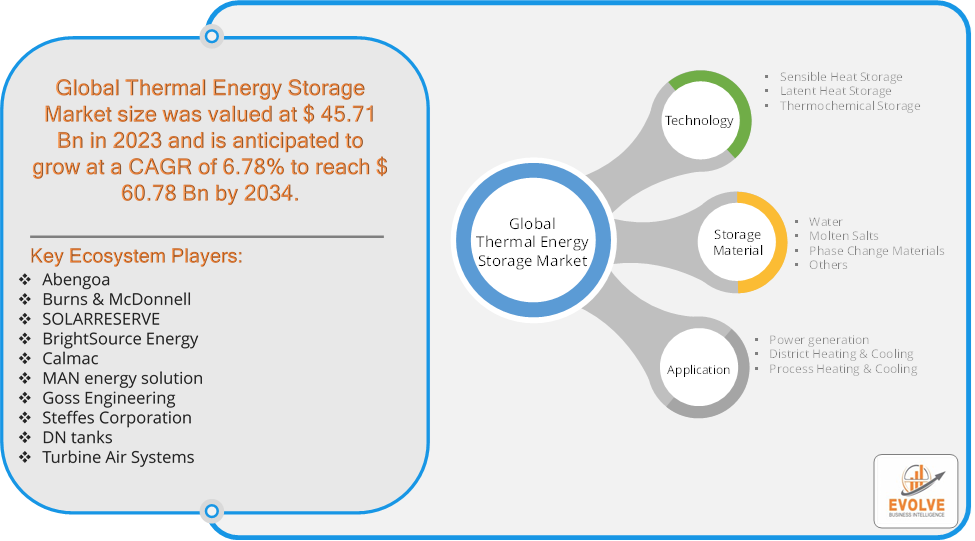Evolve Business Intelligence has published a research report on the Global Thermal Energy Storage Market, 2021–2034. The global Thermal Energy Storage market is projected to exhibit a CAGR of around 4.41%during the forecast period of 2021 to 2034.
Evolve Business Intelligence has recognized the following companies as the key players in the global Thermal Energy Storage Market: Abengoa, Burns & McDonnell, SOLARRESERVE, BrightSource Energy, Calmac, MAN energy solution, Goss Engineering, Steffes Corporation, DN tanks, Turbine Air Systems
The Thermal Energy Storage Market size accounted for USD 45.71 Billion in 2023 and is estimated to account for 46.58 Billion in 2024. The Market is expected to reach USD 60.78 Billion by 2034 growing at a compound annual growth rate (CAGR) of 6.78% from 2024 to 2034. Systems that store thermal energy for later use, providing greater energy management and efficiency, are part of the Thermal Energy Storage (TES) market. Sensible heat storage, latent heat storage, and thermochemical storage are the three main types of TES technology. These systems are widely used in many different applications, such as building cooling systems, industrial operations, and district heating. The industry is driven by the need for grid stability, energy saving programs, and the growing need for renewable energy sources. Lower energy prices, peak load shifting, and improved integration of sporadic renewable energy sources are some of the main advantages of thermal energy storage. The TES market is anticipated to increase greatly in the upcoming years as governments and companies place a greater emphasis on sustainability.
Download the full report now to discover market trends, opportunities, and strategies for success.
Segmental Analysis
The global Thermal Energy Storage market has been segmented based on Technology, Storage Material, Application
Based on the Technology, the market is segmented based on Sensible Heat Storage, Latent Heat Storage, Thermochemical Storage. Sensible Heat Storage typically dominates, primarily due to its established technology, lower costs, and widespread application in various industries, including district heating and industrial processes. This method is favored for its simplicity and efficiency in storing thermal energy using materials like water and concrete.
Based on the Storage Material, the market has been divided into Water, Molten Salts, Phase Change Materials, Others. Water segment generally dominates due to its cost-effectiveness, availability, and efficiency as a storage medium for a variety of applications, including district heating and cooling systems. Water-based systems are widely utilized for their simplicity and reliability in storing thermal energy.
Based on Application, the market has been divided into Power Generation, District Heating & Cooling, Process Heating & Cooling. District Heating & Cooling segment typically dominates due to its widespread application in urban areas for efficient energy management and the growing demand for sustainable heating and cooling solutions. This segment benefits from the integration of renewable energy sources and government initiatives promoting energy efficiency.
Regional Analysis
The Thermal Energy Storage market is divided into five regions: North America, Europe, Asia-Pacific, South America, and the Middle East, &Africa. North America dominates the Thermal Energy Storage market due to several factors. The thermal energy storage market in Europe was valued at USD 11.58 billion in 2021 and is anticipated to increase at a substantial compound annual growth rate (CAGR) throughout the course of the study. Numerous thermal energy storage devices, which are utilized for power generation, district heating and cooling, water heating, and space heating, are characteristic of the area. In addition, the thermal energy storage market in Germany had the most market share, while the thermal energy storage market in the UK had the highest rate of growth in the European Union. The Asia-Pacific region has been witnessing remarkable growth in recent years. From 2022 to 2030, the thermal energy storage market in Asia-Pacific is anticipated to develop at the fastest compound annual growth rate (CAGR). The primary drivers of regional progress are the quick development of renewable energy sources and growing investments in ecologically friendly cooling technologies. Furthermore, the thermal energy storage market in China commanded the most market share, while the thermal energy storage market in India grew at the quickest rate in the Asia-Pacific area.

